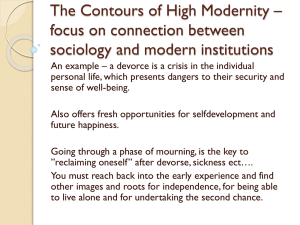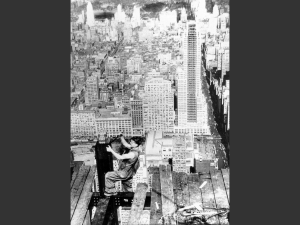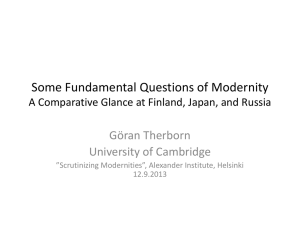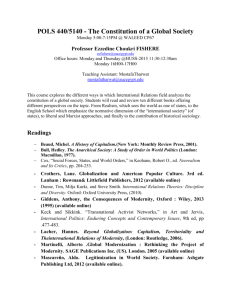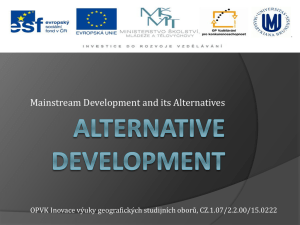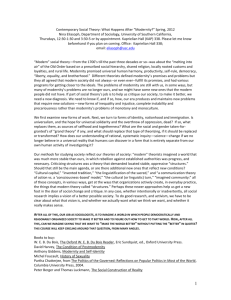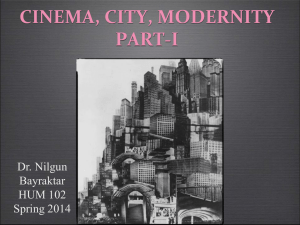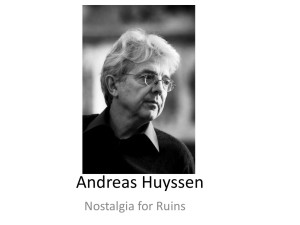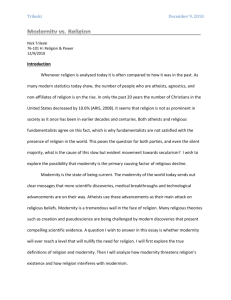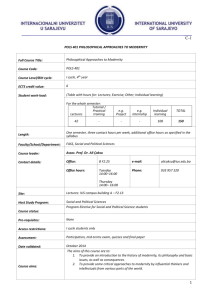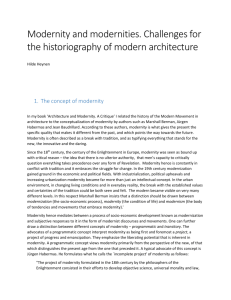Modernity as a Touchstone Concept
advertisement
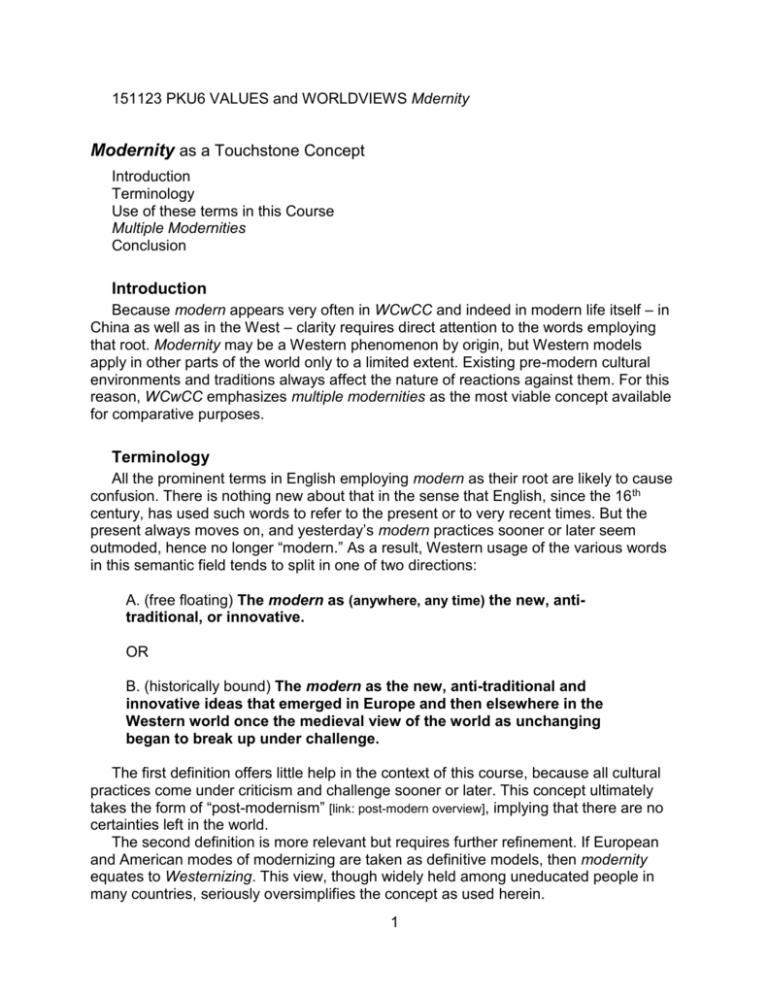
151123 PKU6 VALUES and WORLDVIEWS Mdernity Modernity as a Touchstone Concept Introduction Terminology Use of these terms in this Course Multiple Modernities Conclusion Introduction Because modern appears very often in WCwCC and indeed in modern life itself – in China as well as in the West – clarity requires direct attention to the words employing that root. Modernity may be a Western phenomenon by origin, but Western models apply in other parts of the world only to a limited extent. Existing pre-modern cultural environments and traditions always affect the nature of reactions against them. For this reason, WCwCC emphasizes multiple modernities as the most viable concept available for comparative purposes. Terminology All the prominent terms in English employing modern as their root are likely to cause confusion. There is nothing new about that in the sense that English, since the 16 th century, has used such words to refer to the present or to very recent times. But the present always moves on, and yesterday’s modern practices sooner or later seem outmoded, hence no longer “modern.” As a result, Western usage of the various words in this semantic field tends to split in one of two directions: A. (free floating) The modern as (anywhere, any time) the new, antitraditional, or innovative. OR B. (historically bound) The modern as the new, anti-traditional and innovative ideas that emerged in Europe and then elsewhere in the Western world once the medieval view of the world as unchanging began to break up under challenge. The first definition offers little help in the context of this course, because all cultural practices come under criticism and challenge sooner or later. This concept ultimately takes the form of “post-modernism” [link: post-modern overview], implying that there are no certainties left in the world. The second definition is more relevant but requires further refinement. If European and American modes of modernizing are taken as definitive models, then modernity equates to Westernizing. This view, though widely held among uneducated people in many countries, seriously oversimplifies the concept as used herein. 1 Use of These Terms in This Course In the interests of clarity, this course must impose some order in its own usage, even though differing uses continue to occur elsewhere. The first task is to distinguish among three major variants incorporating this root: modernization, modernism, and modernity (This last is habitually italicized in this course as an important substantive concept with specific implications which are spelled out below) . Modernization In accordance with the dominant Western usage in the social sciences, this term is defined here [link: modernization as socioeconomic concept] as a fundamentally economic process tied to industrialization which affects many wider aspects of life since the industrial surge that began in Britain in the late 18th century. Modernism In accordance with the dominant Western usage in the humanities disciplines, this term is taken here as identifying innovative movements in various arts which emerged mostly early in the 20th century, as in “modernist” literature, painting, or music. These terms have largely become attached to these historical movements, requiring other terms to be assigned by scholars and critics to later developments that seemed distinguishably different. One such term is “post-modernism,” when it is used in a narrow sense pointing to one or another of the arts. Modernity The largest and most vague of these three labels, this term is here taken as identifying a large-scale transformations of the Western world over many centuries that now affect most parts of the world through a process of globalization. The processes of modernity are vast, ultimately unlimited, because they tend to call into question whatever inherited traditions prevail at any given time. Hence, though it may have many different beginnings in different domains of Western civilization, it has – at least so far – no end in sight. Implicitly, modernity calls into question established orders and values – any or all of them. If this process were ever to become complete, the state of civilization might be closer to anarchy than to any known type of order. Thus there is no certainty that modernity could ever be complete as a civilizational process. Instead it may imply ongoing tensions between innovative and tradition-oriented ways of looking at life. The issues vary from one time and place to another, but recognizably similar tensions persist. “Post-Modernism” This term enjoyed considerable currency in the late 20th century aiming at defining a new stage in Western cultural evolution. The implication was that “modernism” was over, replaced by more critical and decentered manifestations of culture. In their celebration 2 of a new perspective, Post-Modernists attacked many Western touchstone beliefs, among them key Enlightenment values like Iiberty/freedom and equality/social justice [link: text]. Still older beliefs also were also attacked: the idea that things have central defining essences, an “essentialism” that began as long ago as the ancient Greeks. The ambition to declare a new stage in Western development may now seem premature, but in a wide range of disciplines Post-Modern thought has played an important role in challenging earlier Western credences. When this study endorses the idea of “multiple modernities,” as will be clear just below, it takes into account the PostModern tendency to free concepts from one “essential” meaning. Post-Modernism helps us to recognize and legitimize the multiple modernities in the world today. This liberation from earlier Western conceptual constraints greatly aids comparative studies. Because nearly everything viewed as “Post-Modern” is framed negatively, against modern or, more narrowly, against Enlightenment ideas [link: the Enlightenment], the movement that goes under this name is hard to summarize. Perhaps the best approach is to look at the Internet (WWW, the World-Wide-Web) as a structural model which epitomizes the characteristics of a typical postmodern worldview [link: text]. In summary, the Internet has no center and no one is in charge of its content. Hence, despite censorship efforts in China, the Internet is inherently directionless and within it “knowledge” blends into “conviction” or “point of view.” If we look at the world in this way, the range of diversity widens, even as it becomes more and more difficult to demonstrate which alternatives are legitimate. Multiple Modernities The West may have been the first civilization to encounter this complex phenomenon, but it does not provide an infallible model for what a modern world should be like. Inevitably, the nature of the preexisting traditions called into question by modernity will have a powerful effect on what develops in each civilization once it is exposed to major challenges to its traditions. Globalization does not imply world-scale uniformity but rather the gradual diffusion of modernity processes throughout the world. Modernity as a reaction against earlier static worldviews (an interpretation derived ultimately from Max Weber [link: Max Weber]) implies that modernity cannot be Western in any exclusive sense. Traditional China, for example, never espoused a worldview similar to that of the Greeks with their insistence on a fundamental unchanging reality hidden under changing appearances. Instead the Chinese tradition saw change itself as the central “reality” [link: Yijing]. Therefore, once China experienced serious challenges to traditional views, beginning most dramatically in the early 20th century, its modernity has distinctly Chinese characteristics. In China, the traditional worldview that was open to challenge involved all the political, social, economic, and cultural aspects of the Han Dynasty, which had remained largely intact for centuries [link: classical correspondences]. In short, modernity must be seen as significantly different in China as compared to the West, not merely in the time frame affecting major developments but in its very substance. Nothing that happens in the West is obligatory for China because of the great differences between them, differences in where they are coming from, in where they are, and in relation to where they will likely choose to go. 3 For such reasons, WCwCC adopts the idea of multiple modernities that has gained prominence among Western thinkers at the beginning of the 21st century. This approach insists that there is no fixed or obligatory model for modernizing. Therefore ethnocentric projections of home experience onto other cultures or civilizations are inappropriate no matter where they may originate. [Recommended reading: Multiple Modernities, vol. 129, No. 1 of Daedalus: Journal of the American Academy of Arts and Sciences (2000).] Conclusion Modernity is an elusive but indispensable concept, called on here to enable comparisons between civilizations that from their beginnings differed greatly from each other. This course, because it conceives modernity as a process of calling into question of inherited ideas and practices, allows both civilizations conceptual space for carrying out their own processes at their own pace. This approach aids comparisons but at a price. Modernity began in the West roughly half a millennium ago, but in China only in the late 19th century. As a result modern sections (Encounters labeled x.2) have an embarrassment of riches to choose among on the Western side of the comparison, while the Chinese texts may seem skimpy in comparison. This imbalance is nonetheless preferable to what many Westerners do without thinking twice about it: identifying modernity with Western Enlightenment ideas and values [link: the Enlightenment]. Imposing those Western preoccupations as a concept of modernity would only subject Chinese phenomena to ethnocentrically Western concerns. Our goal here is to understand Chinese civilization, including its modernity, on its own terms. 4
